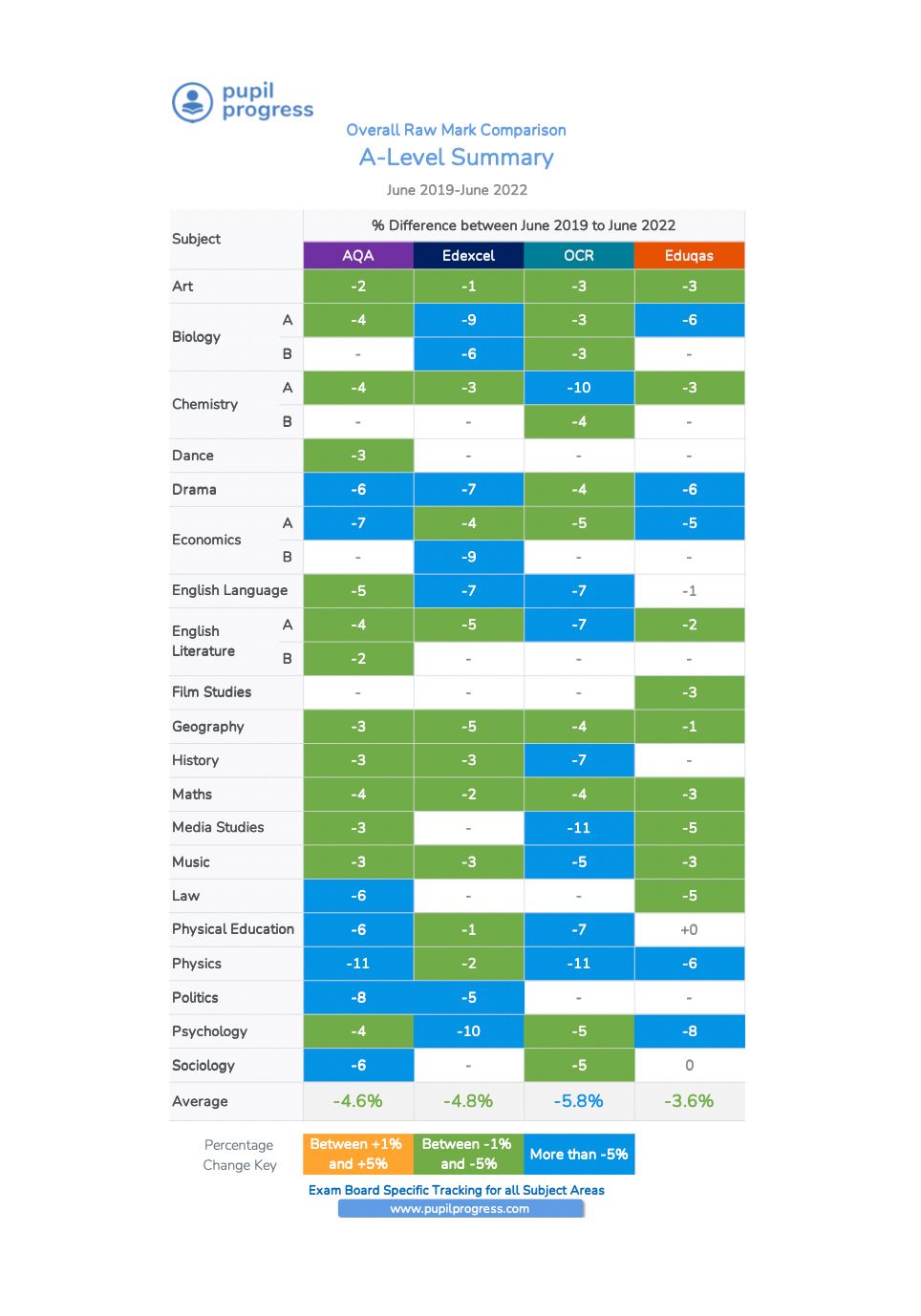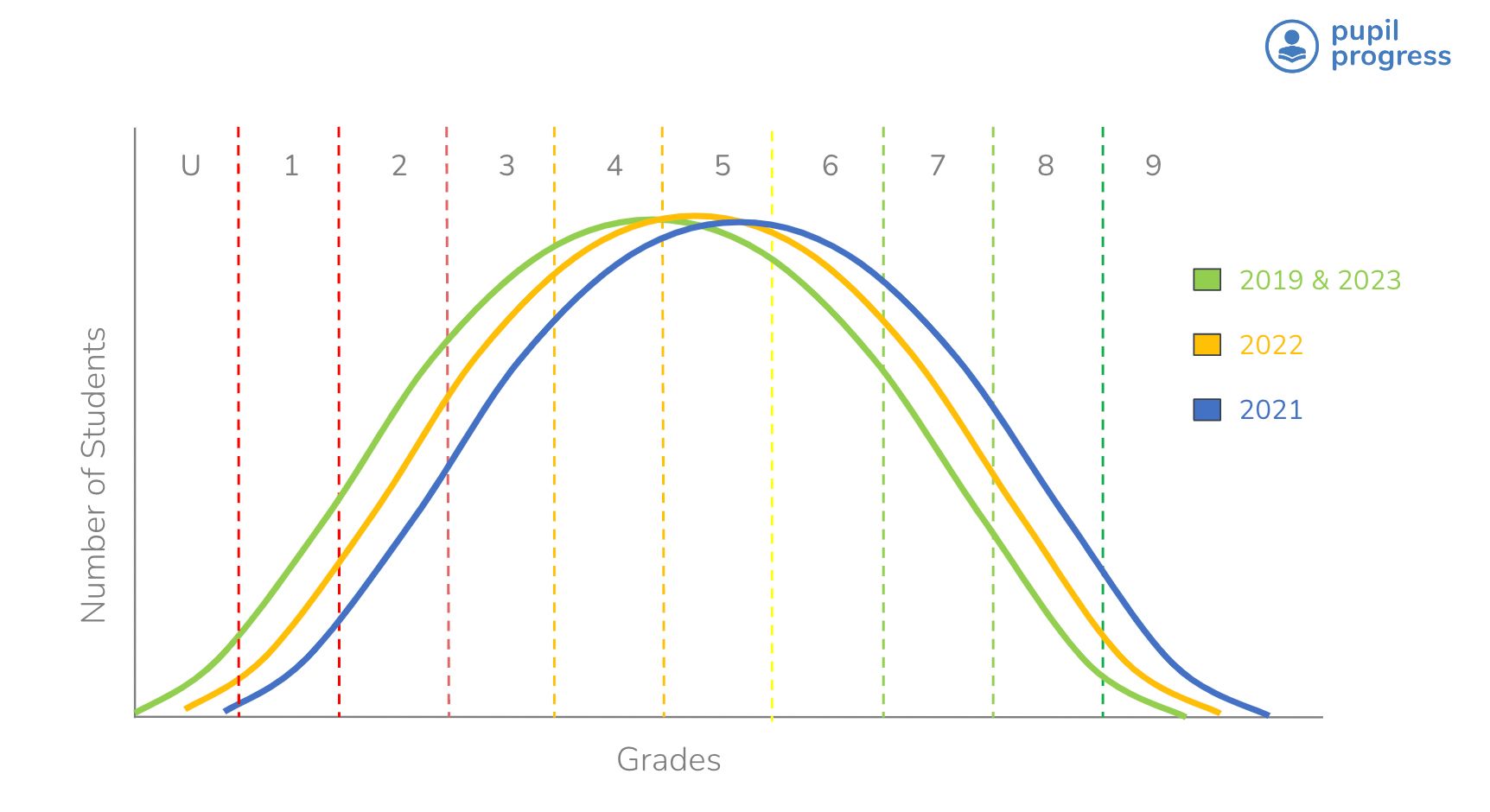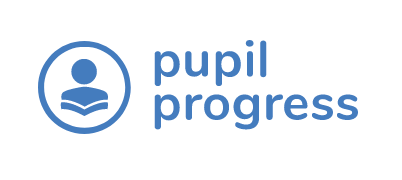Which grade boundaries to use for 2022-23 A-level tracking

With the release of the 2022 boundaries, there have been some changes across a number of subjects. Pupil Progress explores where these have taken place, why these have occurred and, as a result, what grade boundaries to use to track and monitor from September 2022.
Reading time: 5 minutes
What you’ll gain:
- A method to build a consistent approach to grade boundaries across all our subject trackers at A-level
- Analysis to help you to discuss and shape your grade boundary decisions moving into the new academic year
- Why we recommend using the 2022 boundaries plus 4-5% for A-Level
- The information we’ve used to underpin our recommendations
The hard evidence
On A-level results days we:
- Collated the overall grade boundaries for each subject
- Compared the percentage difference between June 2019 and June 2022, for the subject as a whole and a breakdown of boundaries for each unit
- Compared the difference across all exam boards
Across all exam boards, our calculations showed us that on average, the grade boundaries decreased by 4.3% across all A-Level subjects.
Our subject specific breakdown table:

What does this tell us?
Grade boundaries were reduced in every subject across all exam boards with the exception of Eduqas PE at A-Level.
This was in keeping with our expectations that, whilst the level of challenge of assessment was the same as 2019, grade boundaries were expected to drop to ensure Ofqual and the DfE’s requirement for the number of students achieving each grade was somewhere in between 2019 and 2021.
As the grade boundaries were lower, it can therefore be deduced that students achieved less raw marks than the 2019 exam series, and the boundaries were decreased to keep the bell curve proportionate between 2022 and 2019.
Ofqual have stated;
“In 2022 we will aim, therefore, to reflect a midway point between 2021 and 2019. In 2023 we aim to return to results that are in line with those in pre-pandemic years.”
It can be expected therefore that grade boundaries will increase to return the bell curve closer to 2019 levels.

Why have grade boundaries changed?
In normal years, boundaries typically increase each year as teachers learn from the previous exam series. They tailor resources to suit their students, they improve performance in the exams developing better methodologies and practices. Fundamentally they become better at delivering the specification.
The result: Students achieve better marks and boundaries have to increase to keep the bell curve proportionate year on year.
As we move further from this impact, we would expect to see the achievement in raw marks against standardised assessments to return to pre-pandemic levels as classroom learning returns to normal and attendance improves.
Our recommendation for A-Level Grade Boundaries for 2022/23:
The 2022 A-Level grade boundaries in comparison to 2019 show:
- 65% of subjects have a boundary that has decreased by 1-5%
- 9% have a grade boundary decrease greater than 8%
- 5% have a decrease of 10% or more
Using the 2022 boundaries plus 4-5%, depending on the level of challenge of your school, may provide a foundation that is potentially more representative of the grade boundaries we will see in 2023.
Why increase the boundaries from a 2022 baseline?
Given the large variation between each subject and the exam boards that we have seen this year, using 2019 boundaries as a starting point for grade estimates in 2022-23 would not be appropriate. It ignores the difference in impact of the pandemic on different subjects. It could also potentially create a level of challenge too high for some subjects and could prove demotivating for both staff and students alike.
The 2022 boundaries are the most recent and most valid picture that we have. Quite simply they are the actual outcomes from the first full exam series since 2019.
- They represent the outcomes of the disrupted learning of the pandemic years present the truest reflection of our current state of play
- They highlight the nuanced changes that individual units have experienced and provide a real account of the raw marks achieved
There are a few outliers at A-Level that have a larger than normal decrease in their grade boundaries e.g. Physics, Chemistry, Biology and Psychology. The significant majority however are within 4-5% of pre-pandemic levels. Therefore using the 2022 + 4-5% boundaries provides a challenge for some subjects that will see the return to 2019 levels and perhaps even slightly higher.
For those subjects such as Physics A-Level which had a significant decrease, (as high as 11%), it’s realistic to assume that there won’t be a 10% increase by 2023, relating to the point raised earlier, that simply using the 2019 boundaries may provide too much challenge and be demotivating. For these outlier examples, adding 4-5% provides a midpoint to aim for as the subject progresses back to pre pandemic levels (2019).
Let’s apply the theory
- If 2022’s boundaries were to increase by 4% we would see 55% of subjects return to 2019 levels. This is in keeping with comments from Ofqual who are aiming to return the bell curve of grade attainment to pre-pandemic levels
- Using 2022 + 4-5% provides a personalised level of challenge for each subject whilst personalising the trends individual subjects are likely to experience
- It is important to recognise that if you are to use 2022 + 4%, 43% of subjects would be operating with boundaries that are above 2019
However, this will allow for some security for those subjects whilst also giving adequate support to those subjects that suffered a greater percentage decrease in the 2022 exam series.
How choosing realistic grade boundaries builds winning results
Remember that the targets set for students, whether ‘realistic’ or ‘aspirational’ are designed to motivate students. To create a mindset that evokes energy, effort and application. If grade boundaries that students are being measured against are too high, then students will feel more demotivated and that they are not making progress.
By choosing realistic grade boundaries you will be helping your staff and students to show when they are making good progress against their targets and establish where they need to focus their efforts.
Effective tracking and monitoring will identify and highlight the most important information required for the highest level of learning to take place: what do the students actually need to learn in order to progress?
If you have a system that tells you both (where they are and what they need to learn), then everyone is winning!
We might just know someone that can help with this…
Want to unlock your students’ potential?
We provide full, friendly and efficient support at a time convenient to you.
Beth Lunn
Marketing Director

Comments